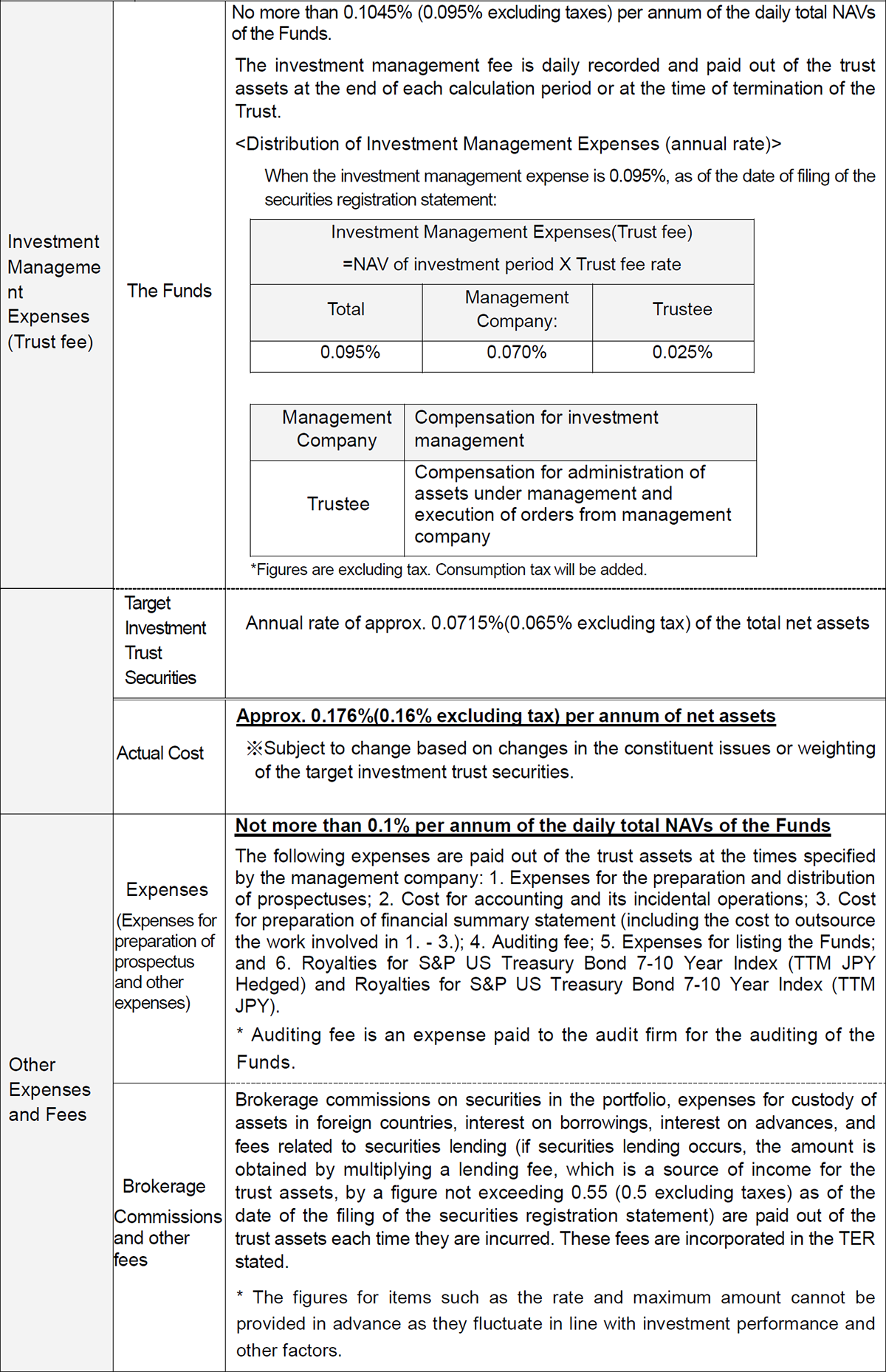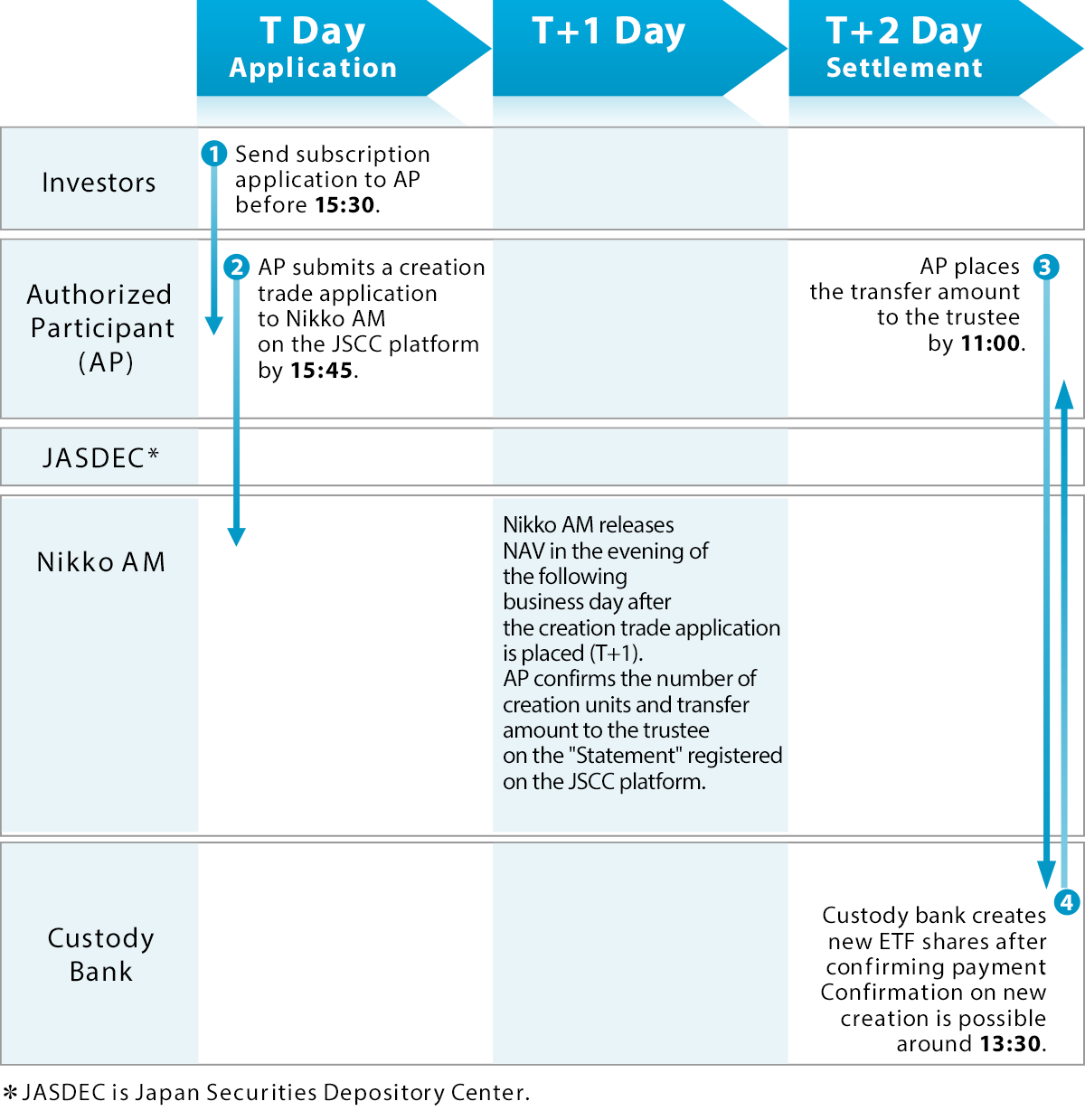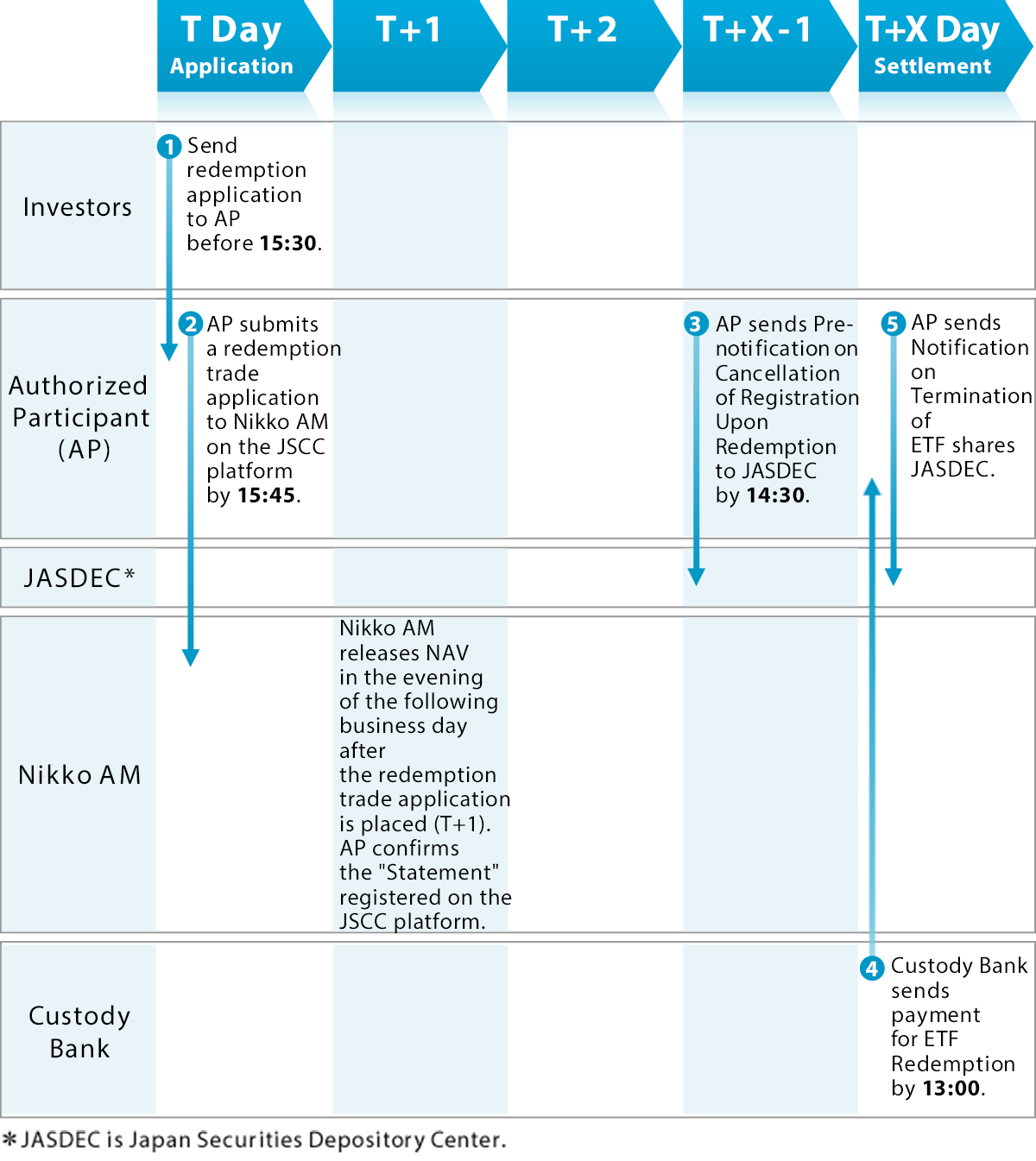On September 1, 2025, Nikko Asset Management Co., Ltd. will change its name to Amova Asset Management Co., Ltd.
The Funds seek to achieve the net asset value per unit to track the performance of the benchmark index by investing mainly in all or portion of separately stipulated investment trust securities.
Key information
| Name: | Listed Index Fund US Bond (No Currency Hedge) |
|
| Code: | 1486 |
Net Asset Value and Performance
Fund of Funds Structure
This Fund of Funds invests in securities held for investment trust.
- US Bond Index Fund No Currency Hedge (for Institutional Investors)
This fund mainly seeks to achieve results that correlate to the movements of the S&P US Treasury Bond 7-10 Year Index (TTM JPY). - Money Account Mother Fund
This Fund seeks to achieve stable returns through stable management by investing in public and corporate bonds.

| Fund Name | Listed Index Fund US Bond (No Currency Hedge) Open-end/Overseas/Bonds/ETF/Index type |
| Listed Exchange | Tokyo Stock Exchange |
| Issue Code | 1486 |
| Targeted Investments | This fund mainly seeks to achieve results that correlate to the movements of the S&P US Treasury Bond 7-10 Year Index (TTM JPY). |
| Date Listed | August 31, 2016 |
| Exchange Trading Unit | 1 unit |
| Trust period | Unlimited (Launch date: August 29, 2016) |
| Computation Period | From 11 January to 10 July, from 11 July to 10 January of the following year |
| Closing Date | On the 10th day of January and July each year *The first closing date will be January 10, 2017. |
| Dividends | As a general rule, the full amount of dividends and other income arising from the trust assets is distributed after deduction of expenses. * There is no guarantee for the amount and payment of dividends in the future. |
Fund Expenses
■Expenses to be borne directly by investors
| Subscription Fee | Independently set by Distributors *Please contact your Distributor for further information. *Subscription fee is compensation for explanation and information providing about the Funds or investment environment, and is also including expense of clerical processing of the subscription. |
| Exchange Fee | Independently set by Distributors *Please contact your Distributor for further information. Exchange fee is compensation for clerical processing of the exchange. |
| Amount to be Retained in Trust Assets | Not applicable |
■Costs paid indirectly by the customer for the trust assets (paid from the Funds)
| TER (Total Expense Ratio) |
Currency Hedge: 0.23% / No Currency Hedge: 0.27% Please refer to the prospectus for details. |

The total amount of expenses of the Funds to be borne by investors varies according to holding length and investment status, and thus cannot be shown.
Major Investment Restrictions
|
Trustee Companies
|
The benchmark index for Currency Hedge is S&P US Treasury Bond 7-10 Year Index (TTM JPY Hedged) and the benchmark index for No Currency Hedge is S&P US Treasury Bond 7-10 Year Index (TTM JPY). As the Funds track total investment returns of US treasury bonds with maturities of 7-10 years, they are classified into one fund with a currency hedge and one fund with no currency hedge.
Further Information
Japan Exchange Group (JPX)
Japan Exchange Group publishes summaries and lists of the ETFs, as well as other valuable information on their website.
S&P Global
- Listed ETF iNav
Please click this link to see the iNAV.
*Link to external sites.
Copyright
“Standard & Poor's®” and “S&P®” are registered trademarks owned by Standard & Poor's Financial Services LLC. Nikko Asset Management Co., Ltd. is licensed to use these trademarks. Standard & Poor’s and its related companies do not sponsor, recommend, sell, or promote Listed Index Fund US Bond (Currency Hedge) and Listed Index Fund US Bond (No Currency Hedge) (hereinafter, the “Funds”), and makes no expression, guarantee, or condition on the suitability of investment in the Funds.
The Funds are not sponsored, endorsed, sold, or promoted by Standard & Poor’s Financial Services LLC and its related companies (hereinafter, “S&P”). S&P makes no expression, condition or warranty, express or implied, as specified to the owners of the Funds’ units or any member of the public regarding the advisability of investing in securities generally or in the Funds particularly, or in the ability of the S&P US Treasury Bond 7-10 Year Index to track the overall market. The relationship of S&P and Nikko Asset Management Co., Ltd. is only in respect of granting the license to use the registered trademarks S&P and the S&P US Treasury Bond 7-10 Year Index. S&P has no obligation to consider requests from Nikko Asset Management's requests or owners of the Funds’ units in determination, creation, and calculation of the S&P US Treasury Bond 7-10 Year Index. S&P has no responsibility for, or involvement in, determining the timings or prices of the Funds, or determining or calculating how to convert units of the Funds into cash. S&P assumes no obligation regarding, nor does it take any responsibility for, management, marketing, or trading of the Funds whatsoever.
S&P does not make any guarantee of the accuracy or completeness of the calculation or basic data of the S&P US Treasury Bond 7-10 Year Index. S&P takes no responsibility for any error, lack, or fault in the S&P US Treasury Bond 7-10 Year Index. S&P and ASX make no explicit or implicit warranty, condition, or expression whatsoever as to the results to be obtained by Nikko Asset Management Co., Ltd., owners of the Funds’ units, or any other persons or organizations from the use of the S&P US Treasury Bond 7-10 Year Index or the data contained therein. S&P expressively disclaims all warranties or conditions of marketability or suitability for a particular purpose or use of the S&P US Treasury Bond 7-10 Year Index or the data contained therein, and makes no guarantee, expression, or condition, express or implied, on marketability or suitability of the Index or the data contained therein.
Without limiting any of the foregoing, S&P is not responsible for any special, punitive, indirect, or consequential damages (including lost profits) arising from the use of the data contained therein, even if notified of the possibility of such damages in advance.
- 21 Feb 2025 — Earnings Report for Fiscal Year ended Jan 2025
- 23 Aug 2024 — Earnings Report for Fiscal Year ended Jul 2024
- 22 Feb 2024 — Earnings Report for Fiscal Year ended Jan 2024
- 23 Aug 2023 — Earnings Report for Fiscal Year ended Jul 2023
- 22 Feb 2023 — Earnings Report for Fiscal Year ended Jan 2023
- 23 Aug 2022 — Earnings Report for Fiscal Year ended Jul 2022
- 22 Feb 2022 — Earnings Report for Fiscal Year ended Jan 2022
- 23 Aug 2021 — Earnings Report for Fiscal Year ended Jul 2021
- 22 Feb 2021 — Earnings Report for Fiscal Year ended Jan 2021
- 21 Aug 2020 — Earnings Report for Fiscal Year ended Jul 2020 (11 Jan 2020 – 10 Jul 2020)
- 22 Feb 2020 — Earnings Report for Fiscal Year ended Jan 2020 (11 Jul 2019 - 10 Jan 2020)
- 23 Aug 2019 — Earnings Report for Fiscal Year ended Jul 2019 (11 Jan 2019 – 10 Jul 2019)
- 22 Feb 2019 — Earnings Report for Fiscal Year ended Jan 2019 (11 Jul 2018 - 10 Jan 2019)
- 23 Aug 2018 — Earnings Report for Fiscal Year ended Jul 2018 (11 Jan 2018 – 10 Jul 2018)
- 23 Feb 2018 — Earnings Report for Fiscal Year ended Jan 2018 (11 Jul 2017 - 10 Jan 2018)
- 22 Aug 2017 — Earnings Report for Fiscal Year ended Jul 2017 (11 Jan 2017 - 10 Jul 2017)
- 23 Feb 2017 — Earnings Report for Fiscal Year ended Jan 2017 (29 Aug 2016 - 10 Jan 2017)
Authorized Participants
- SMBC Nikko Securities Inc.
- ABN AMRO Clearing Tokyo Co., Ltd.
- Barclays Securities Japan Limited
- BNP Paribas Securities (Japan) Limited
- Citigroup Global Markets Japan Inc.
- Goldman Sachs Japan Co.,Ltd.
- Mitsubishi UFJ Morgan Stanley Securities Co., Ltd.
- Mizuho Securities Co., Ltd.
- Nomura Securities Co., Ltd.
Daily Creation and redemption are based on ETF's NAV calculated in early evening. Confirm non-tradable days by referring to trading calendar on our official homepage. Basket for creation is continually-updated on our official homepage.
Basically sell/buy at last price of T day's market while FX rate is TTM of one business day after the application (10am on T+1)
The flow chart below is showing the creation/redemption process for Nikko AM ETFs. Please note that transactions cannot be processed for days on which applications are not accepted.
Creation Flow for Cash Creation/Redemption Type ETFs

Redemption Flow for cash Creation/Redemption Type ETFs

Investors are not guaranteed the investment principal that they commit. Investors may incur a loss and the value of their investment principal may fall below par as the result of a decline in NAV. All profits and losses arising from investments in the Funds belong to the investors (beneficiaries). The Funds are different from saving deposits.
The funds invest primarily in bonds. The NAV of the Funds may fall and you may suffer a loss for reasons such as a drop in the price of bonds or deterioration in financial conditions and business performance of an issuer of stocks. Investors may also incur losses due to exchange rate fluctuations when investing in assets denominated in foreign currencies.
Major risks are as follows:
1. Price Fluctuation Risk
Corporate and government bonds generally have a price fluctuation risk arising from changes in interest rates. Generally, their prices go down when interest rates rise, causing the NAV of the Funds to fall. The degree of price fluctuation varies depending on the remaining time to maturity and the terms of issue in question.
2. Liquidity Risk
Where the market size or trading volume is small, buying and selling prices for securities may be greatly affected. This results in the risk that securities cannot be traded at the expected prices, sold at the appraised prices, or that trading volume is limited regardless of prices. This creates the risk of unexpected losses.
3. Credit Risk
If a default has occurred or is expected to occur, for issuers of public and corporate bonds or short-term financial assets, the prices of such public and corporate bonds or short-term financial assets decline (the value could even fall to zero). This results in a decline of the Funds’ NAVs. In addition, if default in fact occurs, there is a high possibility of being unable to collect invested cash.
4. Currency Fluctuation Risk
For foreign-currency-denominated assets, in general, if the yen is stronger than the currencies of such assets, the fund’s NAV will decline.
5. Security-Lending Risk
Lending securities is accompanied by counterparty risks, which are the risks of default or cancellation of lending agreements as a result of bankruptcy, etc. by the counterparties. As a result, there is a risk that the Funds will suffer unanticipated losses. Following the default or cancellation of a lending agreement, when liquidation procedures are implemented by using the collateral that is set aside in the lending agreement, the procurement cost of buying back the securities can surpass the collateral value, due to price fluctuations in the market. In such a case, the Funds would need to make up for the price difference, and therefore incur losses.
Main Factors Contributing to the Discrepancies between S&P US Treasury Bond 7-10 Year Index (TTM JPY) and NAV
This fund seeks to ensure that its NAV has the same volatility as S&P US Treasury Bond 7-10 Year Index (TTM JPY); however, we cannot always guarantee that the fund will have the same volatility as the Index due to the following factors attributable to this Fund and to the investment trust securities invested in by this fund:
- Lag between the timing of fund inflows and the purchase of investment trust securities.
- Where the portfolio is adjusted through investment in issues other than the constituent issues of S&P US Treasury Bond 7-10 Year Index (TTM JPY) or through changes in the constituent issues or weighting of S&P US Treasury Bond 7-10 Year Index (TTM JPY), the trading of individual issues may be affected by market impact or the fund may bear costs such as management fees, brokerage fees and auditing fees.
- Securities lending fees from lending securities; and
- Where derivative transactions such as futures are conducted, discrepancies in price movements between such transactions and part or all of the constituent issues of S&P US Treasury Bond 7-10 Year Index (TTM JPY).
Discrepancies Between the Market Prices at Which Stocks are Traded on the Exchange and the NAV
The Funds are listed on and will be publicly traded on the Tokyo Stock Exchange; however, the market price of the units will depend mainly on the demand for the Funds, their investment performances, and how attractive they are to investors in comparison to alternative investments, etc. We cannot predict whether the Funds will be traded as a market value below or above their NAVs.
*The prices of securities targeted for investment of the Funds will fluctuate under the influence of the aforementioned risks. Therefore, please note that the Funds themselves have these risks as well.
Additional Considerations
- The provisions stipulated in Article 37-6 of the Financial Instruments and Exchange Act (the "cooling-off period") is not applicable to transactions in the Funds.
- The Funds differ from deposits or insurance policies in that the Deposit Insurance Corporation of Japan or the Policyholders Protection Corporation of Japan does not protect them. Furthermore, units purchased from registered financial institutions, such as banks, are exempted from compensation by the Japan Investor Protection Fund.
- When the Fund faces big redemption causing short term cash requirement or sudden change in the main trading market condition, there can be temporal decline in the liquidity of holding assets, resulting in the risks that Fund unable to trade securities at the expected market prices or appraised prices, or encounters limitation in trading volume. This may result in the negative influence on NAV, suspension of redemption applications, or delay in making payment of redemption.
Risk Management System
- The departments in charge of risk management and compliance will be independent from fund management departments, and will evaluate and analyze risks and performance, risk management, and monitor the status of compliance with laws and regulations.
- To maintain an appropriate management system, the departments in charge of risk management and compliance will report and propose to the committee associated with risk management and compliance, and instruct fund management departments to take corrective actions as necessary.
* The system described above is as of the end of May 2016, and may be subject to change in the future.


